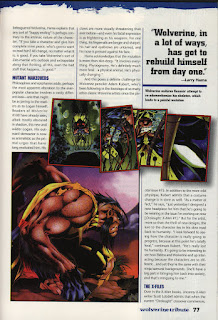
Credits: Joe Casey (writer), Stephen Platt (penciler), Batt, Lary Stucker, Bob Wiacek, Mark Pennington, Johnny Greene, Scott Koblish, & Rod Ramos (inks), Colorgraphix (colors), Mike Heisler (letters)
Summary: In the past, Cable arrives in New York for the first time. He disrupts the Vulture’s first robbery attempt and is injured by a bomb the villain set to cover his escape. A former SHIELD agent named Franklin Rhodes takes Cable in and offers him guidance. Meanwhile, a New Canaanite soldier named D’von Kray materializes in Canada. After Wolverine subdues him for Department H, the agency’s scientists accidentally revive D’von’s memory during their attempt to reprogram him. D’von realizes he’s from the future and that his mission is to kill Cable. He tracks Cable to New York, and during his ambush, kills Franklin Rhodes. Wolverine arrives and helps Cable kill D’von. As Wolverine leaves, he warns Cable about his attitude.
Continuity Notes:
· Cable’s wife, Aliya, is already dead at this point, according to his flashback.
· The Vulture tells Cable that this is his “first endeavor as a master thief.” The implication is that the Vulture had at least some experience as a criminal before meeting Spider-Man for the first time, which seems compatible with his first appearance in Amazing Spider-Man #2.
· According to the opening narrative captions, this story begins two days after Cable arrived from Scotland. Presumably, this is taking place a few days after the events of Cable #-1. He’s still searching for Professor Xavier, which was his motive in that issue.
· If the story is set right after Cable #-1, which as a “Flashback” story had to be set before Fantastic Four #1, having Wolverine as a costumed Canadian agent is questionable. Alpha Flight #2 established that Mac Hudson was inspired to create Canadian heroes after seeing the Fantastic Four on television for the first time. Plus, even though Wolverine’s first appearance in Incredible Hulk #181 doesn’t explicitly establish this is his first mission as a costumed hero, Chris Claremont did have Wolverine say as much during a flashback in Uncanny X-Men. Aaaaand, wasn’t one of those Logan one-shots, which still featured Wolverine as a plainclothes secret agent, already set circa Fantastic Four #1?
· Franklin Rhodes arranges for Cable to get a haircut, which marks the end of Cable’s adventures with the flowing white hair.
· Joe Casey follows Jeph Loeb’s example and has Cable using his telepathy in the past again. Cable’s telepathy was treated as a surprise, even to him, during the X-Force/New Warriors crossover “Child’s Play.”
Production Note: This is a forty-eight page, prestige format book, priced at $5.99.
Review: I remember this comic getting a hostile reaction online; I was tempted to call it the first time the internet realized Joe Casey is far from perfect, but then I recalled the response to his Incredible Hulk run. I don’t think people were expecting Casey’s final Cable story to turn out like this, though -- a largely mindless collection of fight scenes straight out of the early ‘90s. It’s not that Guts and Glory is all bad, though. Using the Vulture in the story’s opening is an unexpected surprise, and it might even by a sly reference to New Mutants #86, which featured the Vulture and Cable in his first cameo appearance. Casey tries to add some meat to the story by pairing Cable with a veteran and discussing the psychological impact of war; he doesn’t have any particularly astute insights on the subject, but the scenes help to humanize Cable. And while Stephen Platt’s art is often too busy and poorly constructed, a few of the pages are at least on the level of a competent Silvestri clone (I’m assuming those are the ones inked by Bob Wiacek or Mark Pennington.)
Unfortunately, this is a six-dollar one-shot that was allegedly going to reveal Cable and Wolverine’s secret past, a mystery that was almost ten years old at the time. What the audience gets is a brief team-up by the characters that doesn’t answer any of the old questions (They don’t even fight! Cable and Wolverine are supposed to be old sparring partners.), art that’s slapped together by an army of inkers, and a story with no message deeper than “war is bad.” It’s hard to feel as if you got your money’s worth.


















